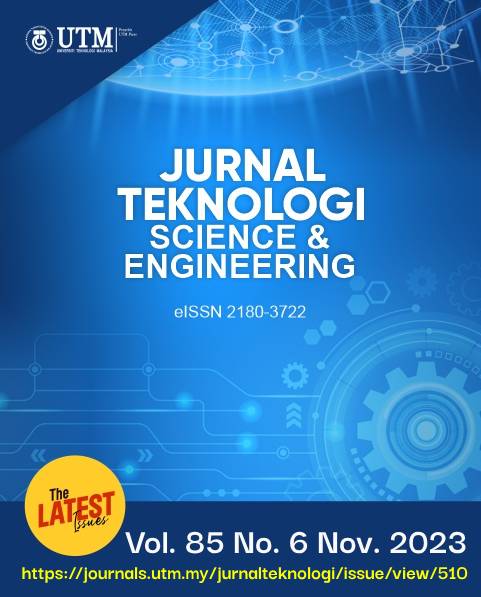THE EFFECT OF OZONE EXPOSURE TO EXTEND THE SHELF LIFE OF CARROTS (DAUCUS CARROTA L.) AGAINST VITAMIN C LEVELS AND HARDNESS
DOI:
https://doi.org/10.11113/jurnalteknologi.v85.20320Keywords:
Food security, shelf life of carrots, ozone, organoleptic, pH, hardness, vitamin cAbstract
The handling of post-harvest agricultural products has an impact on agricultural production. The handling should prevent factors that can lead to a decrease in the quality of agricultural products. Ozone exposure is done to find out the most effective shelf life for carrots. The sample consisted of 3 groups: the control group without ozone treatment (T0), the ozone exposure group through air or spray (T1), the ozone exposure group through immersion in water or soak (T2), and the spray and soak combination group (T3). Ozone exposure time is given for 10 minutes in a closed container. Further observed organoleptic changes, pH, hardness, and vitamin C levels contained in carrots after 1–5 days of storage. The research results showed that ozone treatment with various methods resulted in significant differences (p = 0) in mass loss, pH, and hardness of carrots. Ozone treatment with spray and soak on days 1–5 resulted in the stability of mass loss, pH, and hardness when compared to other treatment methods. The effect of ozone exposure on carrots by spray and soak can extend shelf life with the smallest percentage decrease based on the results of organoleptic tests, mass loss (58%), hardness (35%), and pH (22%), on the 5th day. So, ozone treatment is able to extend the shelf life of carrots based on their organoleptic and physical parameters.
References
Haifan, M. 2017. Review Kajian Aplikasi Teknologi Ozon untuk Penanganan Buah, Sayuran dan Hasil Perikanan (Review Study of Ozone Technology Applications for Handling Fruits, Vegetables and Fishery Products). IPTEK Journal. 1(1): 15-21.
Doi: Https://Doi.Org/10.31543/Jii.V1i1.99.
Mandal, R., Shi, Y., Singh, A., Yada, R.Y. and Pratap Singh A. 2020. Food Safety and Preservation. Encyclopedia of Gastroenterology. 2nd ed.
Doi: https://doi.org/10.1016/b978-0-12-801238-3.65904-4.
Astuti, S. D., Drantantiyas, N. D. G., Putra, A. P., Puspita, P. S., Syahrom, A., Suhariningsih. 2019. Photodynamic Effectiveness of Laser Diode Combined with Ozone to Reduce Staphylococcus Aureus Biofilm with Exogenous Chlorophyll of Dracaena Angustifolia Leaves. Biomedical Photonic. 8(2): 4-13
Doi: 10.24931/2413–9432–2019–8–2–4–13.
Astuty, S. D., Suhariningsih., Baktir, A., and Astuti, S. D. 2019. The Efficacy of Photodynamic Inactivation of the Diode Laser in Inactivation of the Candida albicans Biofilms with Exogenous Photosensitizer of Papaya Leaf Chlorophyll. Journal of Lasers in Medical Sciences. 10(3): 215.
Doi: 10(3):215-224. doi:10.15171/jlms.2019.35.
Bramasto, Y., Zanzibar, P. K., and Danu, M. 2016. The Utilization Gamma Rays Radiation to Improve the Viability of Sengon Seed. Jurnal Hutan Tropis. 4(1): 14-20.
Setiawatie, E. M., Astuti, S. D., Zaidan, A. H. 2016: An In Vitro Anti-microbial Photodynamic Therapy (aPDT) with Blue LEDs to Activate Chlorophylls of Alfalfa Medicago sativa L on Aggregatibacter Actinomycetemcomitans. Journal of International Dental and Medical Research. 9(2): 111-117
Sunarko, S. A., Ekasari, W., and Astuti, S. D. 2017. Antimicrobial Effect of Pleomeleangustifolia Pheophytin a Activation with Diode Laser to Streptococcus Mutans. Journal of Physics: Conference Series. 853: 012039.
Doi: 10.1088/1742-6596/853/1/012039.
Suhariningsih., Winarni, D., Husen, S. A., Khaleyla, F., Putra, A. F., and Astuti, S. D. 2020; The Effect of Electric Field, Magnetic Field, and Infrared Ray Combination to Reduce HOMA-IR Index and GLUT 4 in Diabetic Model of Mus musculus. Lasers in Medical Science. 35: 1315-1321.
Doi: https://doi.org/10.1007/s10103-019-02916-z.
Karaca, H., and Velioglu, Y. S. 2007: Ozone Applications in Fruit and Vegetable Processing. Food Reviews International. 23(1): 91-106.
Doi: https://doi.org/10.1080/87559120600998221.
Karaca, H., and Velioglu, Y. S. 2020. Effects of Ozone and Chlorine Washes and Subsequent Cold Storage on Microbiological Quality and Shelf Life of Fresh Parsley Leaves. Lwt. 109421.
Doi: https://doi.org/10.1016/j.lwt.2020.109421.
Saraslifah, N. M., and Arianto, F. 2016: Pengaruh Ozon yang Dibangkitkan Melalui Reaktor Plasma Berpenghalang Dielektrik Elektroda Silinder Spiral Terhadap Pengawetan Cabai. Youngster Physics Journal. 5(4): 319-326.
Syafarudin, A. 2013. Produksi Ozon dengan Bahan Baku Oksigen Menggunakan Alat Ozon Generator. Jurnal Teknik Kimia. 19(2): 1-9.
Gibney, M. J., Lanham-New, S. A., Cassidy, A., and Vorster, H. H. 2009. Introduction to Human Nutrition. 2nd Edition. USA: Wiley Blackwell.
Han, Y. J., Gharibeshghi, A., Mewis, I., Förster, N., Beck, W., and Ulrichs, C. 2020. Plant Responses to Ozone: Effects of Different Ozone Exposure Durations on Plant Growth and Biochemical Quality of Brassica campestris L. ssp. chinensis. Scientia Horticulturae. 262(August).
Doi: https://doi.org/10.1016/j.scienta.2019.108921.
Astuti, S. D., Wibowo, A., Abdurachman, Triyana, K. 2017. Antimicrobial Photodynamic Effects of Polychromatic Light Activated by Magnetic Fields to Bacterial Viability. Journal of International Dental and Medical Research. 10(1): 111-117.
Puspita, P. S., Astuti, S. D., Nasution, A. M. T., Pradhana, A. A. S., and Mawaddah, A. 2020. Photodynamic Therapy with Ozone Aids to Staphylococcus Aureus Biofilm Reduction. The Indian Veterinary Journal. 97(02): 24-26.
Ikehata, K., and Li, Y. 2018: Ozone-based Processes. Advanced Oxidation Processes for Wastewater Treatment. Emerging Green Chemical Technology. 115-134.
Doi: https://doi.org/10.1016/B978-0-12-810499-6.00005-X.
Astuti, S. D., Arifianto, D., Drantantiyas, N. D. G., Aulia, M. T. N., and Abdurachman. 2017. Efficacy of CNC-diode Laser Combine with Chlorophylls to Eliminate Staphylococcus Aureus Biofilm. Publishing in International Seminar Sensors, Instrumentation, Measurement, and Metrology (ISSIMM), IEEE Xplore 5 January 2017, INSPEC Accession Number: 16563895,
Doi: 10.1109/ISSIMM.2016.7803722.
Hu, H., Zhao, S., Li, P., and Shen, W. 2018. Hydrogen Gas Prolongs the Shelf Life of kiwifruit by Decreasing Ethylene Biosynthesis. Postharvest Biology and Technology. 135(May 2017): 123-130.
Doi: https://doi.org/10.1016/j.postharvbio.2017.09.008.
Glowacz, M., Colgan, R., Rees, D. 2015. The Use of Ozone to Extend the Shelf-life and Maintain Quality of Fresh Produce. Journal of the Science of Food and Agriculture. 95(4): 662-671.
Doi: https://doi.org/10.1002/jsfa.6776.
Suhartati, T. 2017. Dasar-dasar Spektrofotometer UV-Vis dan Spektrofotometer Massa untuk Penentuan Struktur Senyawa Organik. Bandar Lampung: Anugrah Utama Raharja.
Downloads
Published
Issue
Section
License
Copyright of articles that appear in Jurnal Teknologi belongs exclusively to Penerbit Universiti Teknologi Malaysia (Penerbit UTM Press). This copyright covers the rights to reproduce the article, including reprints, electronic reproductions, or any other reproductions of similar nature.
















